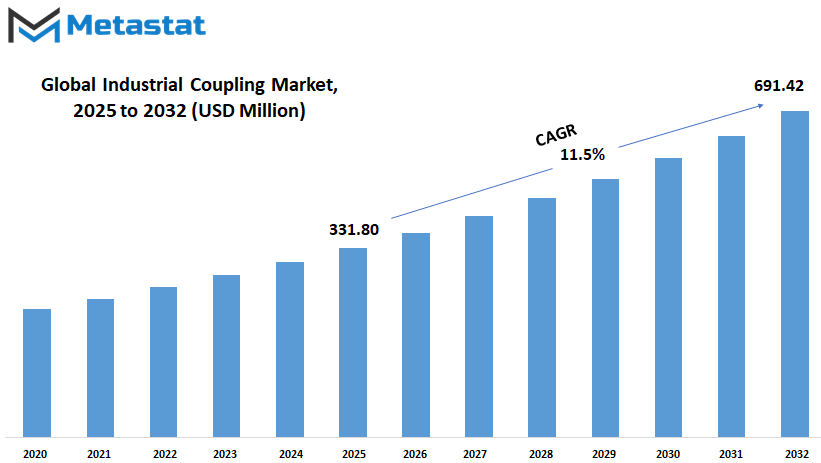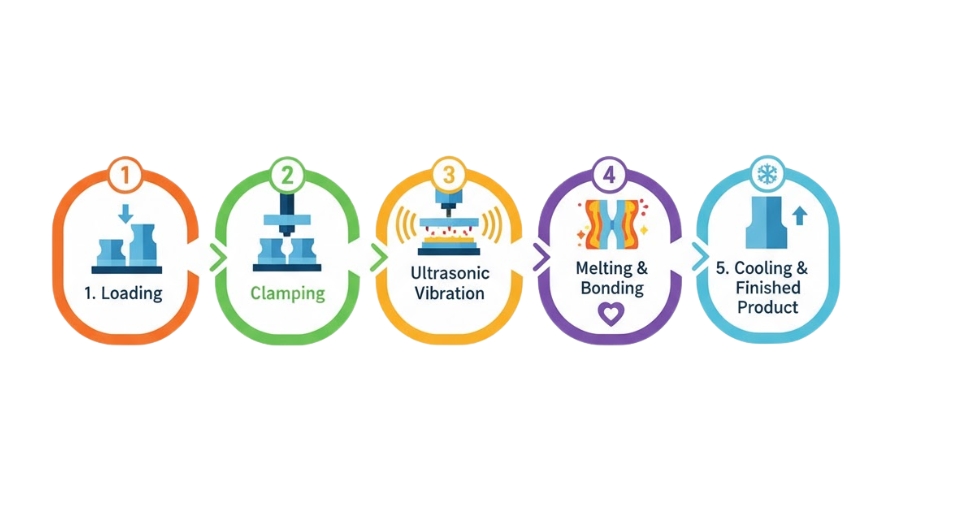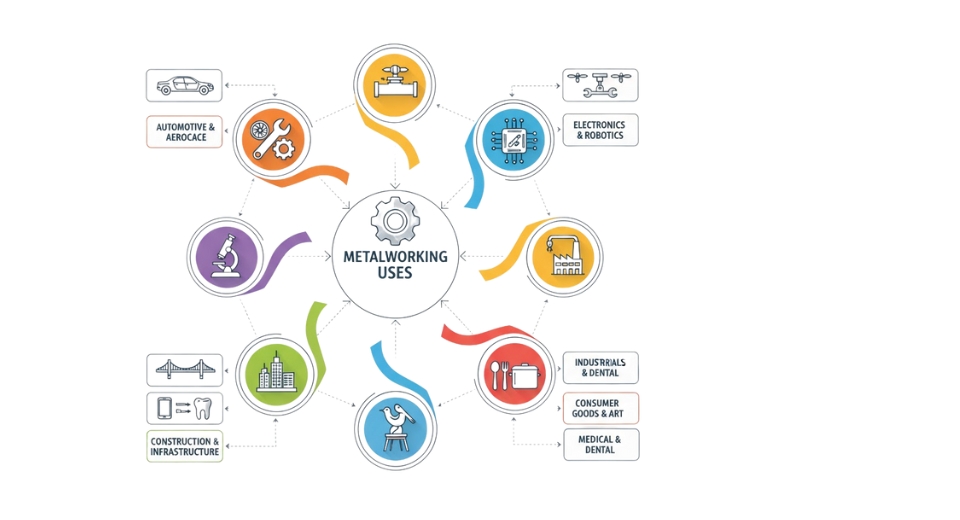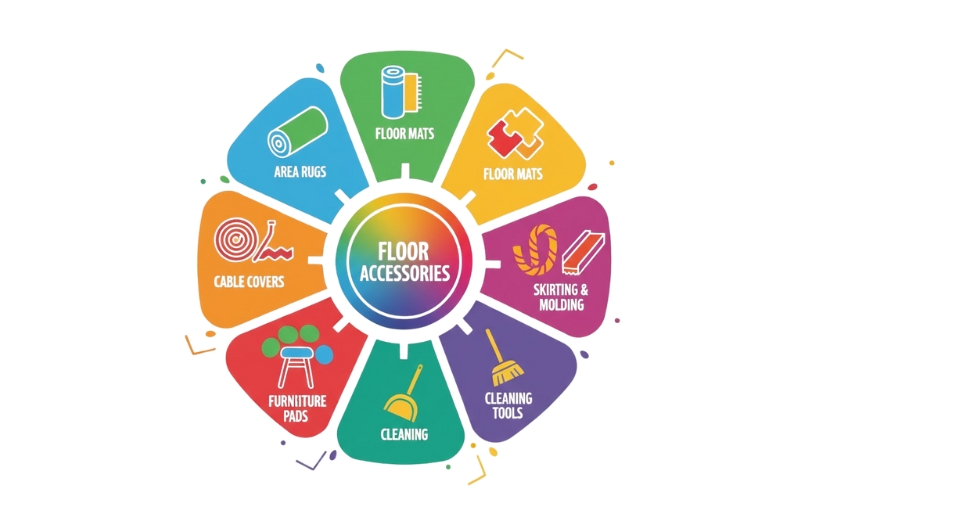MARKET OVERVIEW
The global industrial coupling market, which comes under the mechanical components and power transmission category, will be a key segment concerned with the design, manufacturing, and application of devices that couple two rotating shafts. The components will be designed for the transmission of torque with the provision of slight misalignments, mechanical variations, or motion stoppages. The global industrial coupling market will consolidate a wide array of suppliers, system integrators, and end-use industries, all reliant on precision and reliability in order to maintain the operating efficiency of sophisticated equipment.
The market will involve several industries, such as manufacturing, energy, automotive, mining, construction, marine, and chemical processing. Industrial couplings will be applied in applications like pumps, compressors, gearboxes, and conveyors, where there will be a requirement for continuous mechanical performance. The global industrial coupling market will not only develop basic fittings but will focus on sophisticated solutions that fulfill specific operational specifications. Materials used in the products will vary depending on load-carrying capacity, exposure to environment, and speed need, with materials varying from steel, aluminum to composites, and high-performance polymers.
An important aspect of this market will be customization. Each market will have unique specifications regarding hardness, alignment flexibility, vibration dampening, and thermal resistance. This will lead to product segmentation by function, i.e., rigid, flexible, gear, fluid, and disc couplings. Each class will respond to particular operating challenges like shock absorption, axial movement, and torque fluctuation. Product design and engineering will require mapping product features against performance specifications across different geographies and industrial codes, leading to a multi-layered matrix of innovation and compliance.
The global industrial coupling market will also be driven by automation and machinery optimization trends. With industrial systems making more use of sensor-based monitoring and predictive maintenance best practices, coupling solutions will evolve to support such paradigms. Diagnostic sensors embedded in smart couplings will be applied to detect wear, imbalance, or misalignment and facilitate real-time intervention before mechanical failure occurs. These developments will redefine maintenance practice in industrial machinery and plants, with Global Industrial Coupling manufacturers having to redirect focus away from mechanical design and towards digital compatibility.
The global demand patterns will vary significantly. Economies that have established production bases, extensive as they are today, like the United States, China, Germany, and Japan, will continue to inject high-volume demands. The emerging industrial clusters of Southeast Asia, Latin America, and Eastern Europe will introduce demand structures shaped by local infrastructure needs and regulatory frameworks. This diversity in regional demands will affect production scheduling, supply chain management, and after-sales services models.
Surface treatment technology innovation, corrosion resistance, and light weightage will also have implications on new product line development. Industry players will focus on performance in harsh environments such as marine, high temperature, or chemical exposure. Material science breakthroughs and the long-term pressure of sustainability will leave their signature on green design development, embarking on a new level of engineering ambition.
The global industrial coupling market will continue to establish itself through the balance of mechanical strength, functional precision, and system responsiveness, supporting mission-critical industries that rely on smooth continuous mechanical operation.
Global industrial coupling market is estimated to reach $ 691.42 million by 2032; growing at a CAGR of 11.5% from 2025 to 2032.

GROWTH FACTORS
The global industrial coupling market is slowly molding into a vital aspect of how businesses proceed with automation and efficiency. As businesses turn their attention toward optimizing machine performance and lowering downtime, couplings are the linchpin in maintaining machinery in sync and running smoothly. These mechanical couplings might look straightforward, but they are the basis for energy transfer between moving elements in machines. This makes them essential in systems where consistency and reliability of performance are needed.
There is an increasing trend in all manufacturing industries to implement automated systems that operate faster and more accurately. In these systems, functionality and quality of couplings become important. Industrial couplings assist in minimizing energy loss and mechanical faults, making machines function more efficiently. This need for high-performance machinery is not restricted to one industry; it extends to production lines, assembly work, and even packaging units, all of which depend significantly on the smooth transfer of motion. As companies increasingly look to improve their machinery, the employment of advanced coupling technology will continue to increase steadily.
Besides, nations are investing more in industrial infrastructure and energy developments. Whether one is installing new power plants, increasing oil and gas plants, or installing factory systems, all these need dependable mechanical components. Couplings are increasingly being utilized in such environments to connect pumps and motors, compressors, or turbines. Their shock-absorbing capabilities and facilities for minor misalignments render them indispensable for large operations where failures can be expensive and time-consuming.
Nevertheless, some factors are likely to decelerate the growth of the market. Most coupling types require maintenance to remain in shape. With time, they deteriorate, particularly under high stress and constant utilization. Not only does this contribute to the cost of maintenance but also to equipment failure. The diffusion of low-cost imitations is another issue. These might appear comparable to high-strength couplings but tend to lack the durability and strength required for heavy-duty applications. Consequently, they can be a severe threat to machine performance and safety.
On a brighter note, technical advancements are opening up new possibilities. Next-generation couplings are being engineered with intelligent features to track their own condition and notify users prior to a failure. Self-aligning versions are also on the horizon, simplifying installation and enhancing long-term performance. All these developments are bound to generate robust opportunities for growth in the near future as industries look for intelligent, long-life solutions.
MARKET SEGMENTATION
By Type
The global industrial coupling market will undergo numerous changes as industries expand, technologies develop, and machines require tougher and more elastic connections. These couplings, while small components in vast systems, provide a critical function to maintain smooth running by linking rotating shafts and controlling movement between components of a machine. The future of this market will most probably be defined by a gradual increase in demand for improved efficiency, more durable materials, and intelligent designs that will be able to evolve and meet the demands of new mechanical and digital specifications.
Considering the various types of industrial couplings, each provides a distinct advantage based on the particular requirement of the machinery. Gear couplings, for instance, tend to be employed where there is high torque and machinery must continue running under load. These will continue to be selected in mass manufacturing facilities and processing plants. Disc couplings, however, are preferable in high-speed applications and are appreciated because they are capable of accommodating minor movements or misalignments. As technology advances and machines get faster and more accurate, disc couplings could attract even more interest for their reliable performance.
Grid couplings provide a combination of flexibility and rigidity, which enables them to absorb shock loads better than a great many other designs. This is beneficial in heavy industry where force or jerking is sudden. Jaw couplings are popular because they are easy to use and have a basic design. They find extensive application in smaller applications and could become even more prevalent in compact machinery or new equipment that prioritizes space saving at no compromise in performance. Elastomeric couplings, with their capacity for dampening vibrations, find specific application in areas where noise and wear need to remain minimal. With increasing industries turning towards sustainable operations, elastomeric couplings could find increased application as they help achieve smoother and quieter machinery. Other forms, though not as widespread currently, could become more popular as new applications emerge or machines have requirements not fulfilled by conventional coupling forms.
Over the next few years, the global industrial coupling market will no longer be reliant on machinery requirements but also on how business responds to digital control systems, smart monitoring, and energy savings demands. Materials can evolve, designs can be enhanced, and the function of couplings could expand beyond its mechanical purpose to the incorporation of onboard sensors or data-monitoring capabilities. This transition could alter what these parts are asked to do and where they see themselves within the grand scheme of industry and creativity.
By Material
The global industrial coupling market will continue to register consistent growth in the next few years as a result of its vital role in coupling rotating machinery across industries. Industrial couplings are an integral part of equipment used to transfer power between shafts and are capable of absorbing misalignment and shock loads. As industries continue to develop and include more automation within their operations, there will be a growing need for efficient, long-lasting, and dependable coupling systems.
Materials have an essential role in coupling performance and choice. Among them, steel is a robust and resilient material commonly employed in high-torque applications where resilience is a priority. Steel couplings will continue to be in demand because of their strength and capacity to work under extreme conditions. Aluminum, meanwhile, provides a lighter option and is preferred where minimizing total equipment weight is critical. Its corrosion-resistant property also contributes to its value in moist or chemical-exposed environments.
Cast iron is still a traditional option because of its fair damping of vibrations and lower tensile strength compared to other materials. Its suitability for certain applications, however, may be compromised by its potential weakness in dealing with substances demanding high flexibility or corrosive content. Other materials, such as engineered plastics or composite blends, are also gradually gaining popularity. They are used mostly in specialty applications where weight, sound damping, or non-metallic behavior is required. With industries placing greater emphasis on customization and application-specific design, the utilization of such alternate materials will become increasingly prevalent.
In the future, the global industrial coupling market will be impacted by emerging trends such as smart manufacturing and digital monitoring. Manufacturers will see increasing demand for couplings that enable predictive maintenance and real-time diagnostics. This will minimize downtime and increase the lifespan of machinery. Companies may begin to integrate sensors within coupling systems to capture data on stress, temperature, or alignment in real time. This will maximize operational efficiency and safety.
Sustainability will come into the picture as well. There will be pressure to develop couplings from recyclable materials or with longer life spans to minimize waste and promote green industrial practices. Moreover, global supply networks will drive the need for standardized parts that can be used in multiple systems without needing to be redesigned often.
Overall, the choice of material, innovation, and sustainability will define the future of the global industrial coupling market. With changing industries and more sophisticated systems, the demand for efficient and flexible couplings will continue to increase.
By Application
The global industrial coupling market is likely to have a crucial role in facilitating the future of industrial expansion. Since industries are further automating and increasing their operations, the need for robust and effective mechanical interfaces between equipment will grow consistently. Industrial couplings are major elements in machinery utilized in a broad variety of applications. Whether it is in liquid-transport pumps, pressure-regulating compressors, power-generating generators, material-moving conveyors, or material-blending mixers, couplings play a role to ensure smooth and consistent motion among connected components during operation. That is the reason why the global industrial coupling market is attracting interest from industries that are highly dependent upon performance and efficiency.
In the future, industries will be increasingly challenged to keep high levels of productivity coupled with low energy use and machine wear. This will push companies to invest more effort into higher-end coupling systems that can take high torque but are light in weight and easy to maintain. In pumps and compressors, for instance, couplings will have to minimize vibration and misalignment to avoid equipment failure. When it comes to generators, future couplings are expected to provide improved thermal resistance and heavier load capacity, better addressing the growing demand for reliable power solutions in remote and urban areas.
When considering mixers and conveyors, the focus will probably be on precision and flexibility. As processes for production become more and more sophisticated, the demand for couplings that can be easily adjusted while maintaining production will increase. In food processing, chemical use, and material handling, couplings capable of continuous flow and stable operation will be deemed not only handy but essential.
Additionally, with industries making efforts towards digitalization, there will be a further impetus to include smart capabilities in mechanical elements. Industrial couplings in the future are probably going to be designed with sensors that will track performance in real-time, enabling the operator to identify wear before breakdowns. This move towards predictive maintenance will help deliver safer, more reliable systems across industries.
In summary, the global industrial coupling market is more than maintaining machines in contact. It will be a key force for driving effective and advanced industrial systems. As a result of relentless innovation and upgrading, such parts will define how industries assemble and maintain their equipment, leading to a sustainable and productive future.
By End-Users
The global industrial coupling market will be influenced constantly by technology changes, user needs, and industry-specific issues. Considering this market from the perspective of end-users, it becomes apparent that its evolution will not proceed along one direction. Rather, it will mirror the requirements and expectations of various major industries, such as the automotive sector, aerospace sector, oil and gas sector, manufacturing industry, and power generation.
The auto sector will frame the path of this market with more widespread use of electric and hybrid cars. These cars have alternate mechanical requirements than conventional cars, and couplings need to be set in alternate manners. Lighter material construction, greater torque capacity, and improved durability under new conditions will lead innovation. The market will compel manufacturers to provide more flexible and accurate solutions, particularly as autonomous driving gains popularity and cars need high degrees of mechanical coordination.
Safety, reliability, and weight are key concerns in the aerospace market. Aircraft makers need parts that will withstand harsh environments and not fail. The global industrial coupling market will react by providing materials and designs that enable longer life and greater performance while minimizing weight. This may be in the form of utilizing advanced composites and enhanced engineering techniques to develop couplings that are lighter and more efficient.
The oil and gas sector will continue to be a significant player in this market, particularly as operators seek deeper underwater reservoirs or harsher geology. There will be an increasing demand for high-strength, corrosion-resistant couplings. These parts must be able to withstand pressure and heat, so performance and reliability become crucial. Material that can weather harsh conditions and designs that enable long operational life with low maintenance needs will be the direction of innovation.
In the manufacturing industry, there will be an emphasis on precision, speed, and flexibility. Machines are becoming increasingly intelligent and faster, necessitating couplings that can switch quickly without sacrificing efficiency. With more factories becoming automated, couplings are required to enable high-speed processes and minimal vibration. This change will prompt producers to enhance the way these components are designed into complex systems.
Traditional and renewable power generation will still require reliable couplings. From assisting turbines, generators, or other equipment, a necessity for stability and long-term performance will prevail. The growth of renewable energy sources like wind and solar power will see couplings required to perform well under fluctuating and unpredictable loads, which will accelerate further development in this area.
|
Forecast Period |
2025-2032 |
|
Market Size in 2025 |
$331.80 million |
|
Market Size by 2032 |
$691.42 Million |
|
Growth Rate from 2025 to 2032 |
11.5% |
|
Base Year |
2024 |
|
Regions Covered |
North America, Europe, Asia-Pacific, South America, Middle East & Africa |
REGIONAL ANALYSIS
The global industrial coupling market is influenced by changing requirements, evolving technology, and increasing industrial activity in various regions of the globe. The term Global Industrial Coupling is used to denote mechanical parts that join two turning shafts so that power is transmitted and some amount of misalignment is accommodated. Their significance in multiple industries cannot be disregarded since they ensure the reliability and efficiency of machinery in manufacturing, construction, and the energy sector. As industrial development continues to expand geographically, demand for couplings will similarly follow, based on developments within regions and particular local requirements.
If one examines the geographical segmentation, each region has its own special contribution to the global industrial coupling market. North America, the U.S., Canada, and Mexico constitute its core, and here there is high demand because of the highly developed manufacturing sector that exists here and the continuous requirement for machinery upgrades. Europe, which encompasses the UK, Germany, France, and Italy, is also a prominent region of interest. This region is reputed for its engineering prowess and mature industrial base, reinforcing the requirement for rugged and accurate mechanical systems.
Asia-Pacific will probably contribute even more in the future. Countries such as China, India, Japan, and South Korea are investing heavily in infrastructure and technology, and this is driving their industries to newer levels. This expansion coupled with increasing automation is resulting in a higher demand for components such as couplings to provide smooth mechanical performance. The South American continent, particularly Brazil and Argentina, is catching up as investments in manufacturing facilities and renewable energy initiatives keep increasing, gradually changing the industrial scenario. The Middle East & Africa, primarily the GCC nations, Egypt, and South Africa, are promising due to the persisting construction activities and developments in the energy sector.
What makes this market stand out is the way it's driven not just by economic growth but by technological change. As the world becomes more intelligent and automation becomes the norm, the demand for high-performance, robust, and flexible couplings will increase. The market is not simply responding to change; it is part of the change, quietly playing a critical role in keeping machines operating across various industries.
As industries expand and there is a definite shift toward modernization in all regions, the global industrial coupling market will be an integral component of this expansion. As every region grows at its own rate, all are likely to play their role in creating a more integrated and efficient industrial future.

COMPETITIVE PLAYERS
The global industrial coupling market is anticipated to exhibit steady growth as a result of increasing demand for industrial automation and better mechanical power transmission systems. The sector is important in linking rotating shafts and facilitating effective energy transfer in multiple mechanical configurations. As companies of all industries invest in improving their infrastructure and shifting to more dependable systems, the demand for couplings that can function under extreme conditions will grow even more. Industrial couplings are crucial in machines that serve manufacturing, mining, transportation, and energy, making them a highly valued component of the machinery network.
In the coming years, the trend of this market will most probably be influenced by innovation and competition. Most prominent players like Couplings International, YB Components, Drive & Coupling Solutions Ltd., PTI Group, and Integraflex Ltd will continue investing in superior designs and materials. They will keep their eyes on developing products that are more durable, have lower maintenance requirements, and offer greater performance. As technology becomes increasingly sophisticated, the players will work on developing solutions that are smart and long-lasting. This drive for innovation will not just make equipment more efficient but also minimize downtime in operations, which is something industries value greatly.
Of the established players, Acorn Industrial Services, Coupling Services, Dixon Group Europe, Industrial Clutch Parts Ltd., and John Crane Ltd. still stand out by highlighting reliability and customer care. These companies have established themselves as strong players by providing customized solutions to fit unique client needs. Over the next few years, customers are likely to favor suppliers providing end-to-end services, right from product selection to technical support. Due to this, those businesses that merge technical superiority with "hands-on" service will gain a definite edge.
KTR Systems UK, Renold PLC, and others are bound to play a vital role in driving trends in the future too. They are investing in development and research to beat market needs. With industries looking to be more sustainable and energy efficient, couplings that support sustainability by reducing machine lifecycle cost and delivering better performance with fewer breakdowns will take center stage.
The global industrial coupling market will keep on changing, fuelled by technology development, growing expectations of performance, and stiff competition from leading firms. Firms that remain keen to customer demand and dedicated to innovation are the most likely to take the lead.
Industrial Coupling Market Key Segments:
By Type
- Gear Couplings
- Disc Couplings
- Grid Couplings
- Jaw Couplings
- Elastomeric Couplings
- Others
By Material
- Steel
- Aluminum
- Cast Iron
- Others
By Application
- Pumps
- Compressors
- Generators
- Conveyors
- Mixers
By End-Users
- Automotive Industry
- Aerospace Industry
- Oil and Gas Industry
- Manufacturing Sector
- Power Generation
Key Global Industrial Coupling Industry Players
- Couplings International
- YB Components
- Drive & Coupling Solutions Ltd.
- PTI Group
- Integraflex Ltd
- Acorn Industrial Services
- Coupling Services
- Dixon Group Europe
- Industrial Clutch Parts Ltd.
- John Crane Ltd.
- KTR Systems UK
- Renold PLC
WHAT REPORT PROVIDES
- Full in-depth analysis of the parent Industry
- Important changes in market and its dynamics
- Segmentation details of the market
- Former, on-going, and projected market analysis in terms of volume and value
- Assessment of niche industry developments
- Market share analysis
- Key strategies of major players
- Emerging segments and regional growth potential








 US: +1 3023308252
US: +1 3023308252






